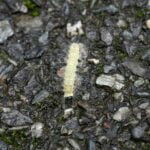Are you tired of sharing your home with creepy, crawly house centipedes? Look no further than this expert advice on how to effectively eliminate these unwanted intruders. With over a decade of experience in pest control, I have honed my skills and developed practical solutions that will help you regain control of your living space. From identifying entry points to implementing preventative measures, I have mastered the art of centipede eradication. In this article, I will share my top tips and tricks for banishing these pests from your home for good. Say goodbye to those unsettling sightings and hello to a centipede-free sanctuary with my proven techniques.

How to Get Rid of House Centipedes: Expert Advice
House centipedes may be harmless, but their presence can be unnerving. If you’re tired of sharing your living space with these creepy crawlies, don’t fret! As a seasoned pest control expert, I’ve got you covered with some effective tips to eliminate house centipedes and restore peace of mind to your home.
Preventing Centipede Infestations: A Proactive Approach
Taking proactive measures to prevent centipede infestations is key to keeping them out of your house for good. Here are some practical steps you can take:
- Address and eliminate moisture: Centipedes love warm and moist areas, so make sure to fix any plumbing leaks, improve ventilation, and reduce excess moisture in your home. This will help create an environment that discourages centipedes from taking up residence.
“By eliminating excess moisture, you’re not only creating an unfavorable environment for centipedes but also for other pests. It’s a win-win situation!”
- Seal cracks and crevices: House centipedes can enter your home through small openings in the foundation and walls. Inspect the exterior of your house and seal any cracks or gaps using caulk or weatherstripping. This will significantly reduce the likelihood of centipedes finding their way inside.
“Think of sealing cracks and crevices as putting up a strong fortress to keep those centipedes out. It’s like building an impenetrable barrier!”
- Keep a clean and clutter-free environment: Centipedes thrive in cluttered and untidy areas. Regularly clean and declutter your living space, paying special attention to basements, attics, and storage areas. This will not only eliminate potential centipede habitats but also discourage other pests from invading your home.
“A tidy and organized space is like a welcome mat for peace of mind. Say goodbye to those hidden corners that centipedes just love to explore!”
Effective Treatment Options: Taking Control of the Centipede Situation
If you’re already dealing with a centipede infestation or want to take more immediate action, here are some treatment options to consider:
- Sticky traps for catching centipedes: Place sticky traps in corners and crevices where centipedes are commonly found. These traps are highly effective at capturing centipedes and preventing them from roaming freely around your home.
“Sticky traps are like little hunters lying in wait for those unwanted centipedes. They’ll catch them red-handed!”
- Address other pest infestations: Centipedes feed on other insects and spiders, so getting rid of other pests in your home can help decrease their numbers. Consider implementing integrated pest management techniques, such as using baits, traps, or eco-friendly pest control products, to eliminate the food sources that attract centipedes.
“By eliminating other pests, you’re essentially cutting off the centipedes’ food supply. It’s like starving them out of your house!”
- Natural deterrents for centipedes: If you prefer to use natural remedies, consider using vinegar or essential oils like peppermint, lavender, or tea tree. These scents are known to repel centipedes, making them less likely to invade your living space.
“With a little help from nature’s aromas, you can create a centipede-free sanctuary. It’s like casting a spell that keeps them away!”
- Insecticides for instant elimination: If all else fails and you’re dealing with a severe centipede infestation, insecticides containing bifenthrin or cypermethrin can provide immediate elimination. Follow the instructions carefully and apply the product in areas where centipedes are present or likely to enter your home.
“Insecticides pack a powerful punch, wiping out centipedes in an instant. It’s like unleashing an army that fights on your behalf!”
Knowing When to Seek Professional Help
In most cases, following the tips mentioned above should help you get rid of house centipedes effectively. However, if you’re dealing with a severe infestation or your efforts haven’t yielded the desired results, it may be time to call in a pest control professional. These experts have the knowledge, experience, and specialized treatments to tackle even the most stubborn centipede problems.
“When it feels like the centipedes have the upper hand, don’t hesitate to call for reinforcements. The professionals know all the tricks of the trade!”
Conclusion
By being proactive in preventing centipede infestations and implementing effective treatment options, you can successfully eliminate those unwanted house guests. Remember to create an environment that discourages centipedes, consider natural deterrents, and seek professional help if needed. With these expert tips, you’ll be well on your way to a centipede-free living space that promotes peace of mind and comfort.
“Don’t let those house centipedes rule your home. Take charge and show them who’s boss! Together, let’s reclaim your space and enjoy a truly centipede-free lifestyle.”
Centipedes are fascinating creatures with a multitude of captivating facts that will leave you in awe. Did you know that centipedes have the ability to regenerate their lost legs? It’s true! These remarkable arthropods can regrow their limbs when they are damaged or severed. If you’re interested in exploring more intriguing facts about centipedes, click here to uncover a world of knowledge about these remarkable creatures. Get ready to have your mind blown as you delve into the world of centipedes and discover just how incredibly unique they are. Happy exploring!
How to Get Rid of Centipedes: A Simple Guide
[youtube v=”hPmftbyRGSE”]
Identifying and Dealing with Centipedes in Your Home
Centipedes are arthropods that are known for their frightening appearance and numerous legs. While they feed on insect pests, they can become a nuisance in our homes, and some species are even venomous to humans. In this guide, we will provide you with effective methods to identify and get rid of centipedes so that your home can remain free from these invasive predators.
It is crucial to begin any pest control plan by accurately identifying the pest at hand. Many people find centipedes to be freaky-looking, and they are not wrong. In the United States, centipedes can vary greatly in size, ranging from one to six inches in length. They have flattened bodies and can come in various colors such as yellow, brown, black, gray, or red. Contrary to their name, they do not have 100 legs but can have anywhere from 30 to over 300 individual legs. It’s important to note the distinction between centipedes and millipedes, which are similar pests but belong to different arthropod groups. While centipedes have one pair of legs per body segment, millipedes have two. Additionally, centipedes are rare invaders in the United States, with species like the bark centipede, cryptobid centipede, and scolopindrid centipede being more common in certain regions. However, the house centipede is a frequent invader in households across the country.
To effectively control centipedes, the next step is to inspect your property for signs of their presence or hotspots of activity. Centipedes invade homes in search of food and shelter, with their diet consisting mainly of insects like roaches, moths, flies, and other common home-invading insects. While some people consider centipedes to be beneficial, their continued presence can indicate a larger pest problem. Centipedes are adept at hiding and can move around different areas of the home. Dark and moist areas, such as basements, garages, bathrooms, and crawl spaces, are prime spots for centipedes. It is essential to check these areas, moving boxes and clutter aside to eliminate potential hiding spots. Additionally, inspect your outdoor area for standing water and excessive moisture, such as near bricks, wood piles, and leaves. Seal any entry points around your structure, such as cracks or voids in the walls, and take note of all the sites that require attention.
Once you have identified the centipede species and inspected your property, it’s time to start treatment. Before doing so, ensure you wear personal protective equipment and keep people and pets away from treated areas until dry. Begin by addressing high moisture sites, both indoors and outdoors, identified during your inspection. Repair leaks, reduce humidity using dehumidifiers or air conditioners indoors, and employ lawn care techniques like raking, detaching, and trimming to promote air circulation and water evaporation outdoors. By reducing moisture levels, centipedes will be less likely to stay active in your home.
Next, use products specifically labeled for centipede control. Reclaim I.T. and Defense Dust are two effective insecticides that can be used for both indoor and outdoor treatment. Reclaim I.T. is a liquid insecticide concentrate that can control over 70 pests, including centipedes and their food sources. Calculate the square footage of your lawn to determine the amount of Reclaim I.T. needed, using a rate of 0.5 fluid ounces per gallon of water for every 1,000 square feet. Apply Reclaim I.T. using a hand pump sprayer in a low-pressure spray, making a broadcast application over your entire lawn, including ornamental beds, bricks, and rocks. Treat the entry points you noted earlier, such as doors, windows, vents, and voids in the walls. Then, conduct a perimeter treatment around your structure by spraying three feet up the structure and three feet outwards. When applying indoors, use Reclaim I.T. for spot and crack and crevice applications, such as around plumbing or underneath appliances. Spray along the baseboards to target centipedes and other insects. Defense Dust is a water-resistant insecticidal dust that can be applied to voids, cracks, and crevices to prevent pests from invading. Apply Defense Dust at a rate of 0.5 pounds per 1,000 square feet, using a handheld duster to treat tight areas. Treat along the edge of carpeting, baseboards, and high moisture areas like sinks and appliances.
To monitor future centipede and pest activity, set up traps using Pro Glue Boards. Place them parallel to the wall near entry points but out of reach of children and pets. These boards will catch any pests that attempt to invade your home. If someone gets stuck on a glue board, loosen the stickiness with vegetable oil.
Prevention is key to keeping centipedes at bay even after treatment. Maintaining a low moisture environment in and around your home is crucial, as centipedes are prone to dehydration. Additionally, make follow-up applications of Reclaim I.T. every three months to ensure year-round control.
By taking a proactive approach and implementing effective treatment options, you can successfully eliminate centipedes from your home and create a pest-free living space. Remember to address moisture issues, use insecticides as needed, and set up traps for monitoring. With these strategies, you can keep your home centipede-free and enjoy a peaceful environment.
Sources:
– Solutions Pest & Lawn. “How to Get Rid of Centipedes (4 Easy Steps).”
– Image Credit: Unsplash

FAQ
Question 1: Are house centipedes harmful?
Answer 1: House centipedes are generally harmless to humans. While their presence can be unsettling, they do not pose a significant threat and are unlikely to bite unless provoked.
Question 2: How can I catch house centipedes?
Answer 2: Sticky traps are effective at catching house centipedes in corners and crevices. Placing these traps in areas where centipedes are commonly spotted can help monitor and control their population.
Question 3: Can getting rid of other pests prevent centipede infestations?
Answer 3: Yes, removing other pests such as spiders, ants, and silverfish can help prevent centipede infestations. House centipedes feed on these smaller pests, so reducing their presence can make your home less attractive to centipedes.
Question 4: Should I exterminate house centipedes?
Answer 4: House centipedes actually help control other pests, so there is little reason to exterminate them unless their presence becomes excessive or poses a problem. It is best to focus on prevention and creating an environment where centipedes are less likely to thrive.
Question 5: What are some natural remedies to deter centipedes?
Answer 5: Natural remedies like vinegar and essential oils, such as lavender or peppermint, can be used to deter house centipedes. Spraying these substances in areas where centipedes are commonly found may help discourage their presence.
- Unlock 6000+ words beginning with he: A comprehensive analysis - April 20, 2025
- Mastering -al Words: A Complete Guide - April 20, 2025
- Master Scrabble: High-Scoring BAR Words Now - April 20, 2025
















